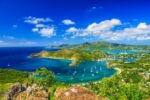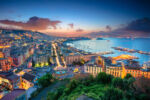
How to capture the best photographs according to an expert
From wildlife to sunsets, waterfalls to the aurora borealis, here’s how to capture the best photographs on your next water-based adventure according to Phoebe Smith, who won a Cruise Line International Association award for her Antarctica photography
There’s an old adage that the best camera is the one you have in your hand.
While there’s some truth in that, to take photographs worthy of printing out and hanging on your wall – or making others green with envy when you post them on social media – there is a little more to it.
Luckily there are some simple tips that will instantly lift the quality of your snaps from amateur to pro.
And the best thing? They work even if you’re shooting on your smartphone.

THE BASICS
Before you even pick up a camera, the first thing to consider is what you want your image to show. A picture can say a thousand words, so what do you want yours to say? Once you know the answer you can decide three things.
The first is what your focal point or subject will be – every shot should have one, whether it’s your cruise ship, an elephant or a market trader selling spices. Next, consider what to keep in the frame – and more crucially – what to leave out.
Before you press the shutter release, the final piece of the puzzle is composition; that is making sure all the elements in the photograph work together.
The ‘rule of thirds’ method helps you do this quickly. Imagine an image is divided by two evenly spaced horizontal lines and two evenly spaced vertical lines, dividing the photo into nine equal parts.
The point of interest, or ‘subject’ should be placed at a point where two lines intersect.
Look at an image you like and apply this imaginary grid to it; you’ll soon realise that most good photographs are composed this way.
Once you start practising this, your photos of wildlife, landscapes and people will automatically get better.
CAPTURING WILDLIFE SHOTS
Wildlife photographer Mike Unwin has been on many expedition cruises worldwide, including a recent Viking cruise.
The author of Around the World in 80 Birds says, “Wildlife – especially seabirds and cetaceans – can appear at any time, especially on sea days when you’re moving between destinations.
So spend as much time on deck as possible. Find a place where you can access both sides of the ship quickly and find comfortable spots where you can lean against the side while supporting your camera.
While ensuring you are outside to capture any animal action, it’s also worth checking to see if your camera has any in-built pre-sets. Look for a sport mode to capture fast-moving birds and sealife such as dolphins.
When you are on land watching critters, think about composition again. “When faced with a huge crowd of animals – a teeming colony of fur seals or lines of gannets on a cliff – always try to select one individual as your focus,” advises Mike. “If you just ‘point and shoot’ into the crowd, assuming you can’t miss, you often fail to capture anything satisfactory.”
Mike’s biggest tip is to remember to include some scenery to ‘place’ the animal. “Marine wildlife is often seen against impressive backdrops such as icebergs or cliffs, and you can often capture a more pleasing composition and tell a better story by framing your subject within these,” he explains. “You can always crop in afterwards, if necessary.”

PHOTOGRAPHING PEOPLE
Including people in photographs is a great way to showcase different cultures and create a sense of scale when shooting landmarks.
There’s a travel photography rule that says you should always ask permission before taking someone’s picture.
Though this isn’t an issue if you’re capturing an overall scene, it’s certainly good etiquette if you are making an individual the subject of your photograph.
But it can be tricky, says Bella Falk, a documentary director, founder ofpassportandpixels.com and photographer who’s a regular Travel Media Awards finalist.
“I try to approach each situation respectfully and always ask permission if I’m close to the person,” she says. “If I’m after a natural scene, I’ll ask permission, take the unavoidable awkward shot, wander off, then come back when they’ve forgotten about me to get the more natural image I am after.”
Even if you don’t speak the language, Bella says a friendly smile and gesture to your camera is enough to get your meaning across. After you’ve taken a photo of someone, be sure to show it to them – it can make their day – and if you promise to send it to them, keep your word.
FANTASTIC FESTIVALS
Crowds of people at events can make for excellent shots but it’s easy to become overwhelmed and be unable to find a focus. Bella’s main tip is to go early to scope out possible locations for strong shots.
Once the action starts, she recommends that you “look for stories and details – fabulous outfits, great characters, faces enjoying themselves, or elements such as decorations or sets.”
Above all, Bella advises that you be sociable. “Chatting to people is a way of finding great subjects. Also, if you’re having a good time and enjoying the vibe, your energy will be better and you’ll take better photos.”
Movement can be an issue at festivals so use your camera’s action shot pre-set.
More experienced photographers can change the shutter speed – something that many smartphones can also do now.
This works well for shooting waterfalls, where a slow shutter speed creates that beautiful flowing effect.

STARS, SUNRISES AND THE NORTHERN LIGHTS
Natural phenomena such as radiant sunrises and sunsets, a sky filled with thousands of stars or a clear winter’s night under the aurora borealis are often the highlight of a cruise. But capturing them can be hugely frustrating.
Timing is everything. You may have
heard of the ‘golden hour’, a term used
to describe the best light conditions
for pictures. It is just before sunset
and just after sunrise, when the light
is softer than full daylight. Ensuring
you’re outside at these times means
a better chance of powerful snaps.
For stars and the aurora borealis you will need to check the weather: clouds are your enemy. Be aware that in places such as the Arctic, where you have the best chance of seeing both, conditions can change fast.
Having a tripod is crucial for this type of picture says Dave Sandford, a photographer who’s worked with Getty Images and National Geographic Traveller. The Polar Bear International ambassador also advises using your camera or smartphone’s self-timer to prevent camera-shake when you push the shutter release button.
“Remember to put the camera away, too,” he suggests, “to ensure that you take a moment to actually enjoy your surroundings.”
INSTAGRAM IDEAS
When it comes to the ’gram, keep it simple. Orientation is most important, as you need to shoot vertically for reels and stories.
To get the perfect shot for an Instagram carousel – a post containing more than one photo or video, which users can flick through – use a square setting.
Putting together a reel really allows you to tell a story about your trip – whether it’s a video showing a behind-the-scenes look at your cabin, the facilities on board or a series of photos that highlight a single destination.
So capture a mix of stills and videos and keep them in separate folders on your phone to make editing them together quick and easy.
EQUIPMENT
For beginners, a smartphone camera is suitable to practise all the pro tips on the previous pages. Invest in a digital single-lens reflex camera (DSLR) later on if you want to change lenses.
Bella adds, “Once you’re ready to move up, there are excellent entry- level DSLR and mirrorless cameras that come with a kit lens, which are a great way to get off auto mode and start practising with controlling aperture and shutter speed.” Models include Canon EOS R100, Canon EOS Rebel SL3 or Nikon Z fc. A zoom lens that takes you from 100-300mm or more will be a great investment.”
Proficient photographers have more options, says Mike. “For an expert, the sky’s the limit. Prime [non-zoom] lenses are best for optical quality and light-gathering. They are expensive but they produce the best results.”
Cameras have certainly come along way over the years, and there are additional toys such as GoPros which are great for underwater shots, and 360 cameras, which offer drone-like effects without the faff of carrying a drone and checking local laws and regulations for permission to use it.
However, no matter what equipment you have at your disposal, just remember the basics of composition and visual storytelling – and you’ll return home with some cracking shots to share with friends and loved ones, or even hang above the mantle.












